Detailed Analysis of Accounting Systems and Processes Assignment
VerifiedAdded on 2020/05/28
|19
|2069
|38
Homework Assignment
AI Summary
This document presents a comprehensive solution to an accounting systems and processes assignment. It begins by addressing cell naming in spreadsheets, the representation of negative numbers, and the importance of separating data and report areas. The solution then explores the application of IF functions and contrasts perpetual and periodic inventory systems. It further explains the use of spreadsheets for financial reporting and provides detailed workings and revised data for specific questions. The assignment also delves into the impact of computers on online retail, using eBay as an example. A significant portion of the assignment is dedicated to a case study on Qantas Airways, analyzing its financial statements from 2012 to 2017, including key financial ratios such as Return on Investment, Return on Equity, and Net Profit Margin, to assess its suitability for shareholder investment. The document concludes with a recommendation to postpone investment consideration until the company's profit trend stabilizes. The document includes references to academic sources.
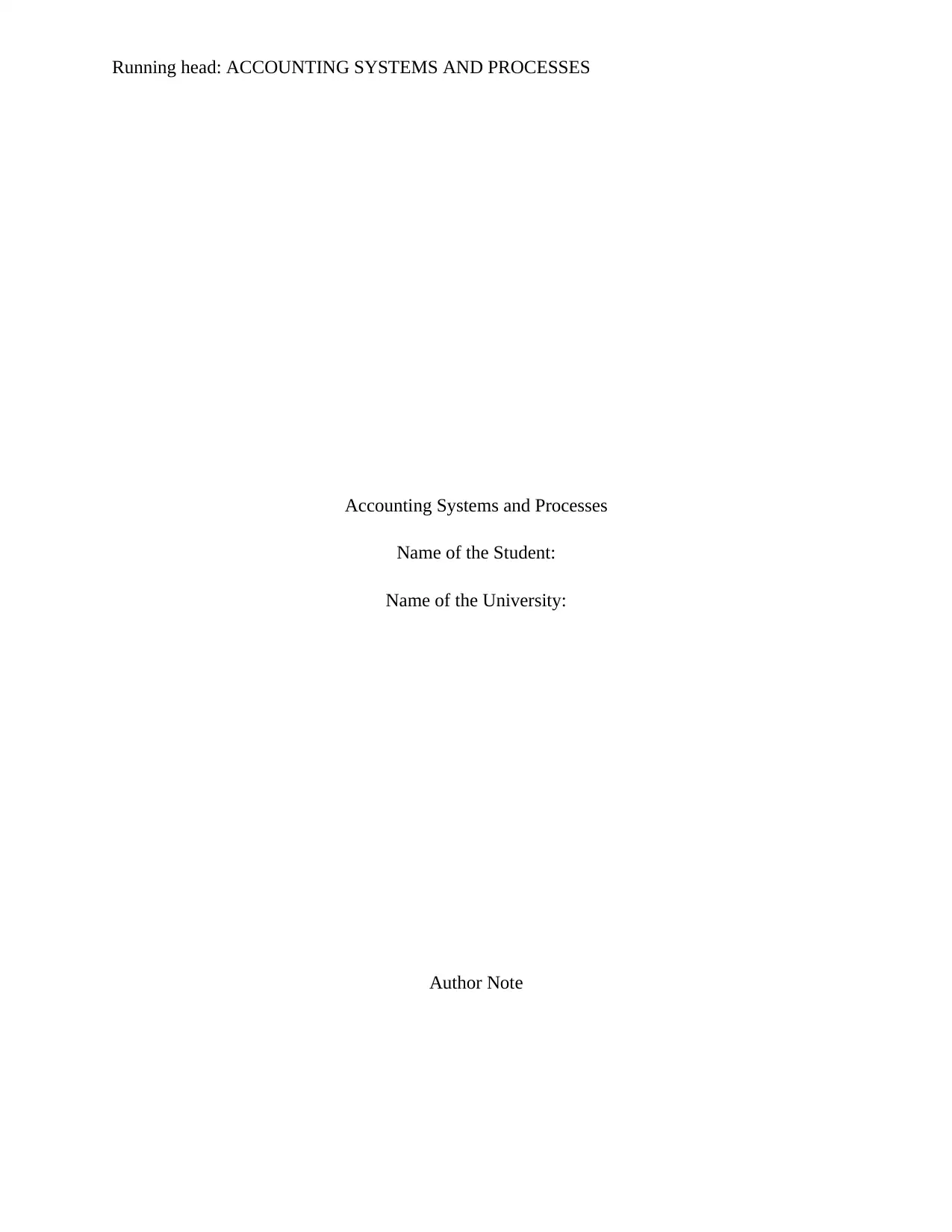
Running head: ACCOUNTING SYSTEMS AND PROCESSES
Accounting Systems and Processes
Name of the Student:
Name of the University:
Author Note
Accounting Systems and Processes
Name of the Student:
Name of the University:
Author Note
Paraphrase This Document
Need a fresh take? Get an instant paraphrase of this document with our AI Paraphraser
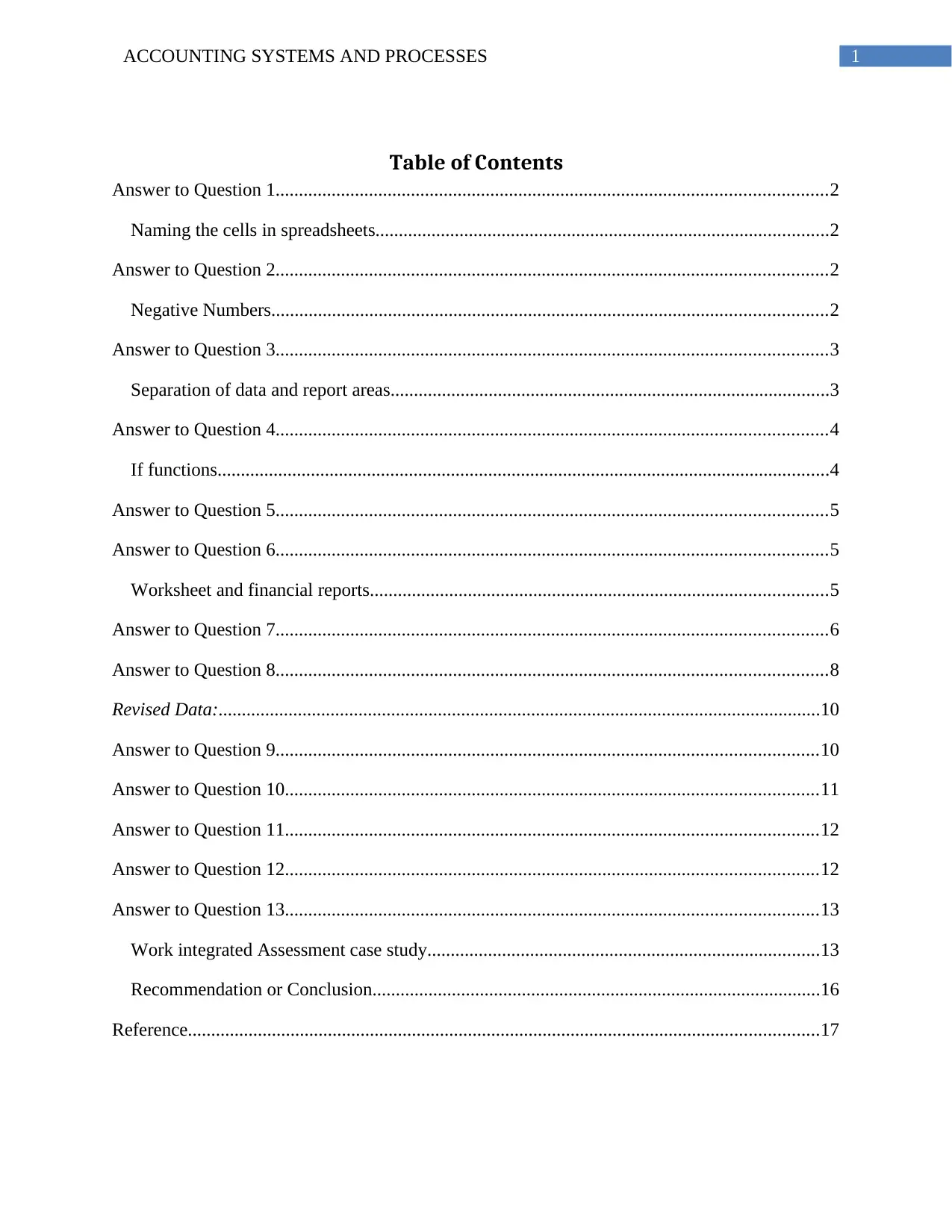
1ACCOUNTING SYSTEMS AND PROCESSES
Table of Contents
Answer to Question 1......................................................................................................................2
Naming the cells in spreadsheets.................................................................................................2
Answer to Question 2......................................................................................................................2
Negative Numbers.......................................................................................................................2
Answer to Question 3......................................................................................................................3
Separation of data and report areas..............................................................................................3
Answer to Question 4......................................................................................................................4
If functions...................................................................................................................................4
Answer to Question 5......................................................................................................................5
Answer to Question 6......................................................................................................................5
Worksheet and financial reports..................................................................................................5
Answer to Question 7......................................................................................................................6
Answer to Question 8......................................................................................................................8
Revised Data:.................................................................................................................................10
Answer to Question 9....................................................................................................................10
Answer to Question 10..................................................................................................................11
Answer to Question 11..................................................................................................................12
Answer to Question 12..................................................................................................................12
Answer to Question 13..................................................................................................................13
Work integrated Assessment case study....................................................................................13
Recommendation or Conclusion................................................................................................16
Reference.......................................................................................................................................17
Table of Contents
Answer to Question 1......................................................................................................................2
Naming the cells in spreadsheets.................................................................................................2
Answer to Question 2......................................................................................................................2
Negative Numbers.......................................................................................................................2
Answer to Question 3......................................................................................................................3
Separation of data and report areas..............................................................................................3
Answer to Question 4......................................................................................................................4
If functions...................................................................................................................................4
Answer to Question 5......................................................................................................................5
Answer to Question 6......................................................................................................................5
Worksheet and financial reports..................................................................................................5
Answer to Question 7......................................................................................................................6
Answer to Question 8......................................................................................................................8
Revised Data:.................................................................................................................................10
Answer to Question 9....................................................................................................................10
Answer to Question 10..................................................................................................................11
Answer to Question 11..................................................................................................................12
Answer to Question 12..................................................................................................................12
Answer to Question 13..................................................................................................................13
Work integrated Assessment case study....................................................................................13
Recommendation or Conclusion................................................................................................16
Reference.......................................................................................................................................17
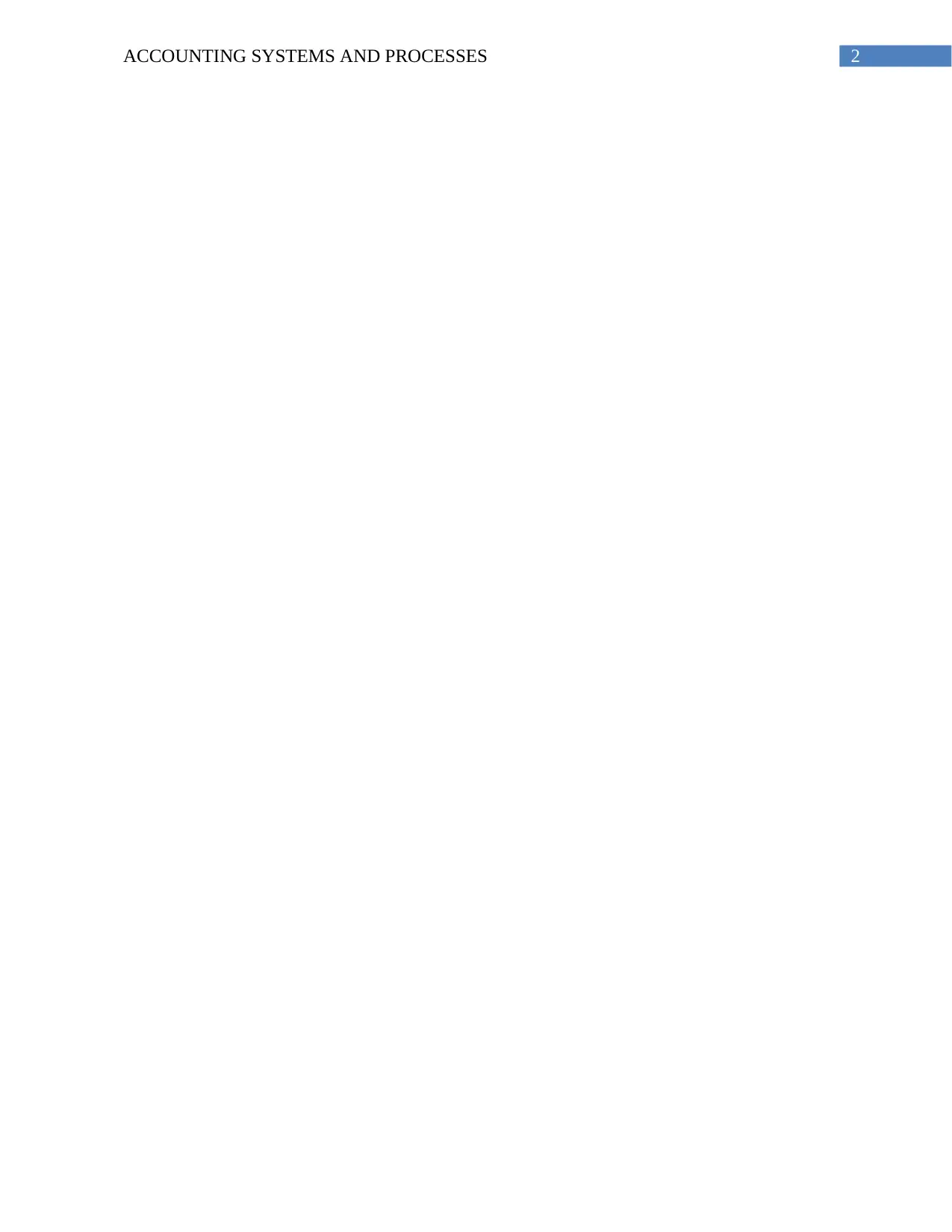
2ACCOUNTING SYSTEMS AND PROCESSES
⊘ This is a preview!⊘
Do you want full access?
Subscribe today to unlock all pages.

Trusted by 1+ million students worldwide
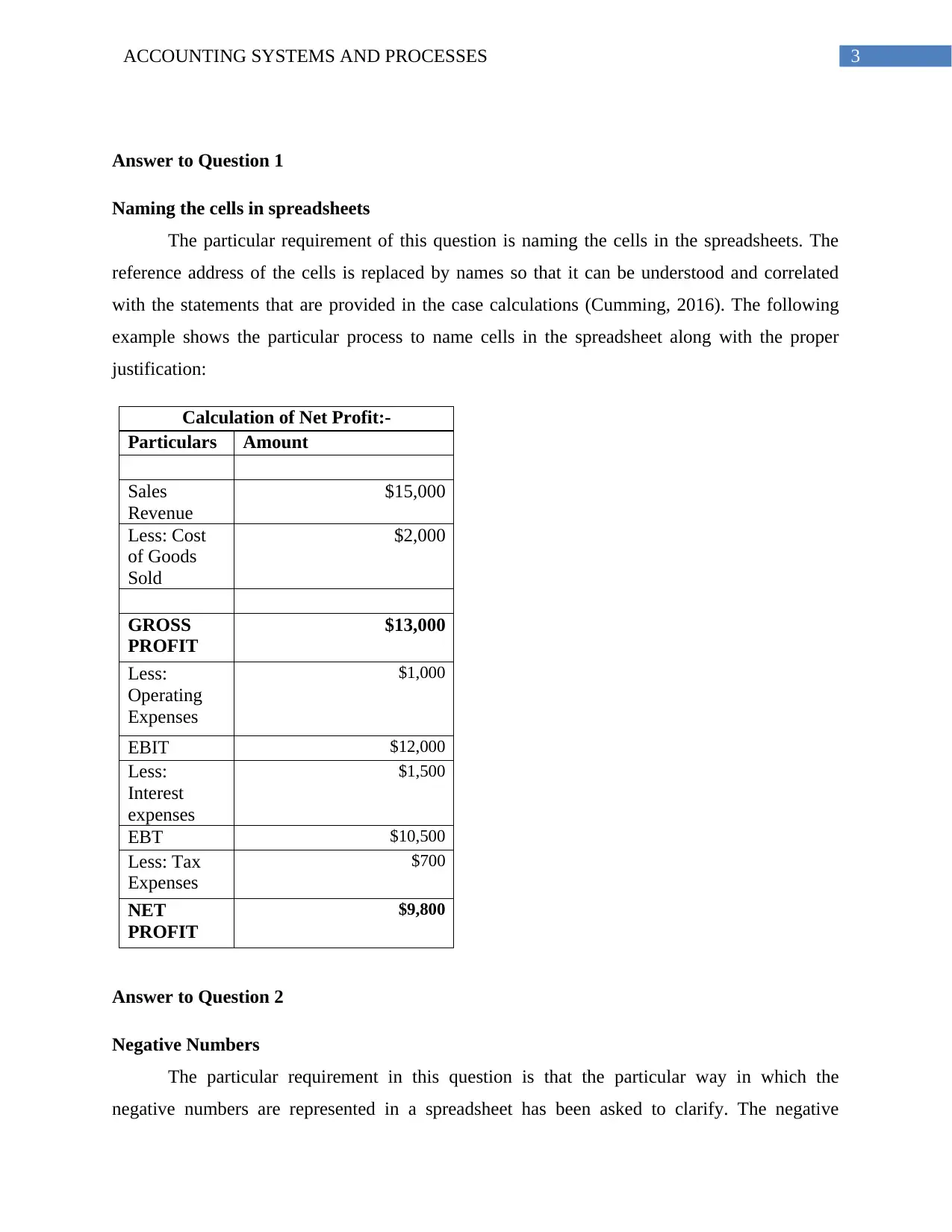
3ACCOUNTING SYSTEMS AND PROCESSES
Answer to Question 1
Naming the cells in spreadsheets
The particular requirement of this question is naming the cells in the spreadsheets. The
reference address of the cells is replaced by names so that it can be understood and correlated
with the statements that are provided in the case calculations (Cumming, 2016). The following
example shows the particular process to name cells in the spreadsheet along with the proper
justification:
Calculation of Net Profit:-
Particulars Amount
Sales
Revenue
$15,000
Less: Cost
of Goods
Sold
$2,000
GROSS
PROFIT
$13,000
Less:
Operating
Expenses
$1,000
EBIT $12,000
Less:
Interest
expenses
$1,500
EBT $10,500
Less: Tax
Expenses
$700
NET
PROFIT
$9,800
Answer to Question 2
Negative Numbers
The particular requirement in this question is that the particular way in which the
negative numbers are represented in a spreadsheet has been asked to clarify. The negative
Answer to Question 1
Naming the cells in spreadsheets
The particular requirement of this question is naming the cells in the spreadsheets. The
reference address of the cells is replaced by names so that it can be understood and correlated
with the statements that are provided in the case calculations (Cumming, 2016). The following
example shows the particular process to name cells in the spreadsheet along with the proper
justification:
Calculation of Net Profit:-
Particulars Amount
Sales
Revenue
$15,000
Less: Cost
of Goods
Sold
$2,000
GROSS
PROFIT
$13,000
Less:
Operating
Expenses
$1,000
EBIT $12,000
Less:
Interest
expenses
$1,500
EBT $10,500
Less: Tax
Expenses
$700
NET
PROFIT
$9,800
Answer to Question 2
Negative Numbers
The particular requirement in this question is that the particular way in which the
negative numbers are represented in a spreadsheet has been asked to clarify. The negative
Paraphrase This Document
Need a fresh take? Get an instant paraphrase of this document with our AI Paraphraser
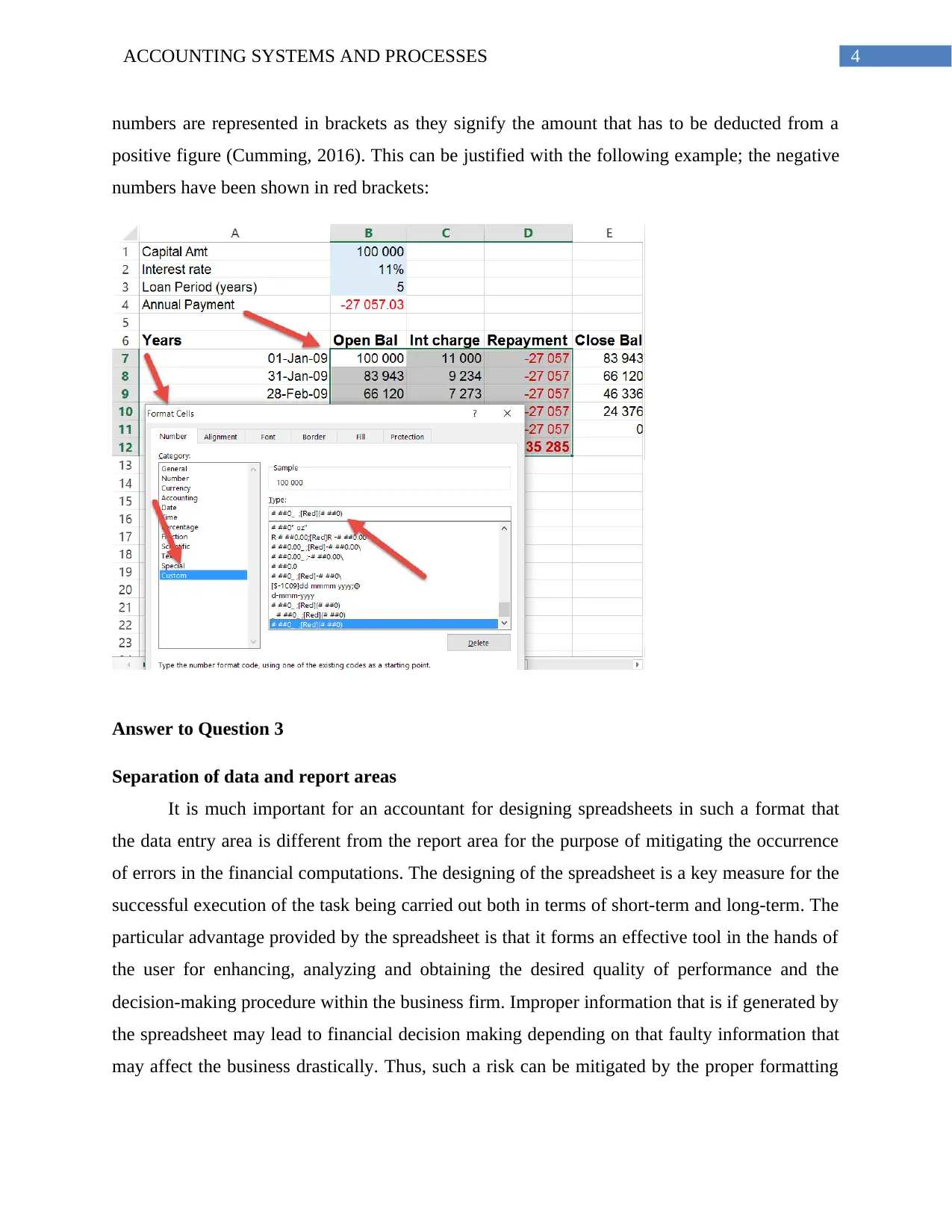
4ACCOUNTING SYSTEMS AND PROCESSES
numbers are represented in brackets as they signify the amount that has to be deducted from a
positive figure (Cumming, 2016). This can be justified with the following example; the negative
numbers have been shown in red brackets:
Answer to Question 3
Separation of data and report areas
It is much important for an accountant for designing spreadsheets in such a format that
the data entry area is different from the report area for the purpose of mitigating the occurrence
of errors in the financial computations. The designing of the spreadsheet is a key measure for the
successful execution of the task being carried out both in terms of short-term and long-term. The
particular advantage provided by the spreadsheet is that it forms an effective tool in the hands of
the user for enhancing, analyzing and obtaining the desired quality of performance and the
decision-making procedure within the business firm. Improper information that is if generated by
the spreadsheet may lead to financial decision making depending on that faulty information that
may affect the business drastically. Thus, such a risk can be mitigated by the proper formatting
numbers are represented in brackets as they signify the amount that has to be deducted from a
positive figure (Cumming, 2016). This can be justified with the following example; the negative
numbers have been shown in red brackets:
Answer to Question 3
Separation of data and report areas
It is much important for an accountant for designing spreadsheets in such a format that
the data entry area is different from the report area for the purpose of mitigating the occurrence
of errors in the financial computations. The designing of the spreadsheet is a key measure for the
successful execution of the task being carried out both in terms of short-term and long-term. The
particular advantage provided by the spreadsheet is that it forms an effective tool in the hands of
the user for enhancing, analyzing and obtaining the desired quality of performance and the
decision-making procedure within the business firm. Improper information that is if generated by
the spreadsheet may lead to financial decision making depending on that faulty information that
may affect the business drastically. Thus, such a risk can be mitigated by the proper formatting
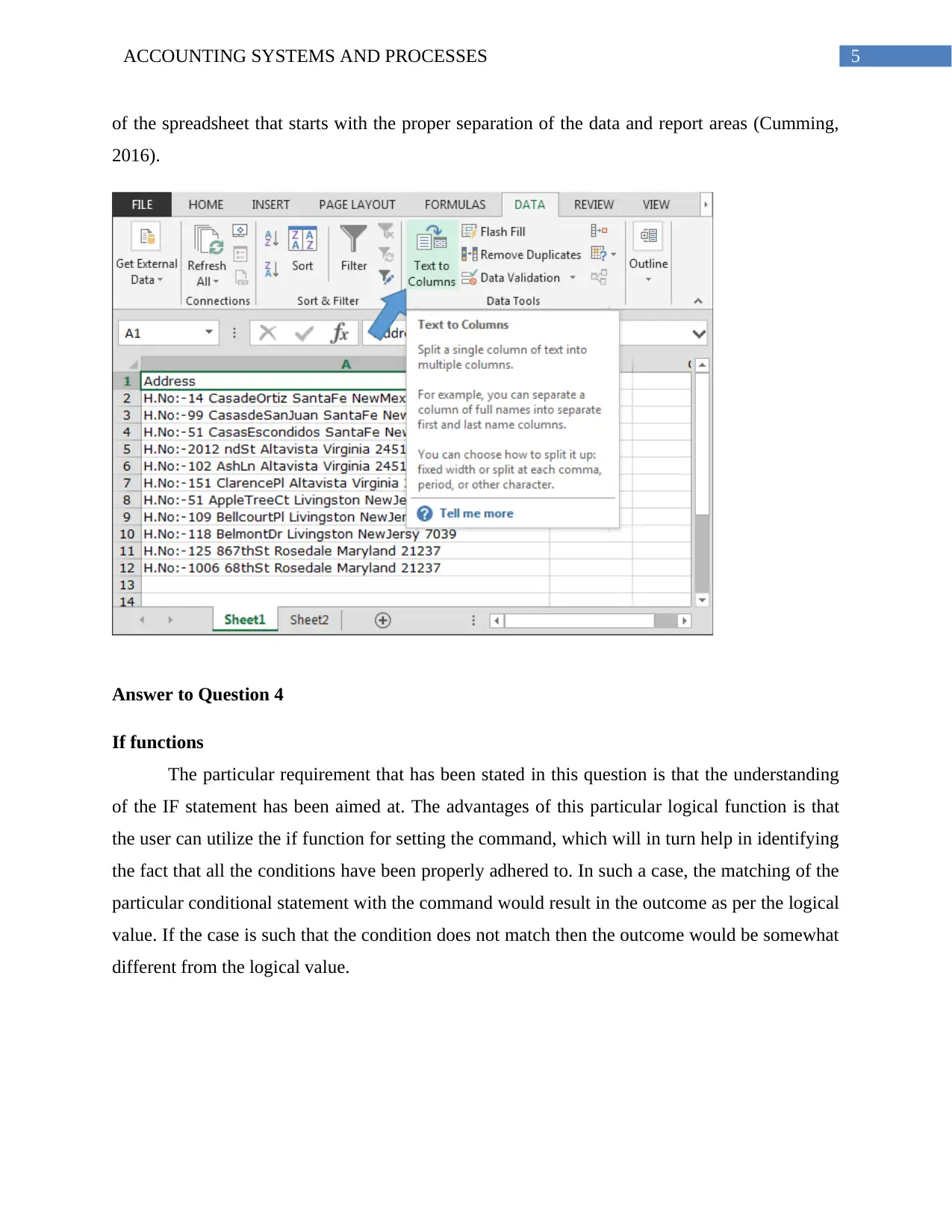
5ACCOUNTING SYSTEMS AND PROCESSES
of the spreadsheet that starts with the proper separation of the data and report areas (Cumming,
2016).
Answer to Question 4
If functions
The particular requirement that has been stated in this question is that the understanding
of the IF statement has been aimed at. The advantages of this particular logical function is that
the user can utilize the if function for setting the command, which will in turn help in identifying
the fact that all the conditions have been properly adhered to. In such a case, the matching of the
particular conditional statement with the command would result in the outcome as per the logical
value. If the case is such that the condition does not match then the outcome would be somewhat
different from the logical value.
of the spreadsheet that starts with the proper separation of the data and report areas (Cumming,
2016).
Answer to Question 4
If functions
The particular requirement that has been stated in this question is that the understanding
of the IF statement has been aimed at. The advantages of this particular logical function is that
the user can utilize the if function for setting the command, which will in turn help in identifying
the fact that all the conditions have been properly adhered to. In such a case, the matching of the
particular conditional statement with the command would result in the outcome as per the logical
value. If the case is such that the condition does not match then the outcome would be somewhat
different from the logical value.
⊘ This is a preview!⊘
Do you want full access?
Subscribe today to unlock all pages.

Trusted by 1+ million students worldwide
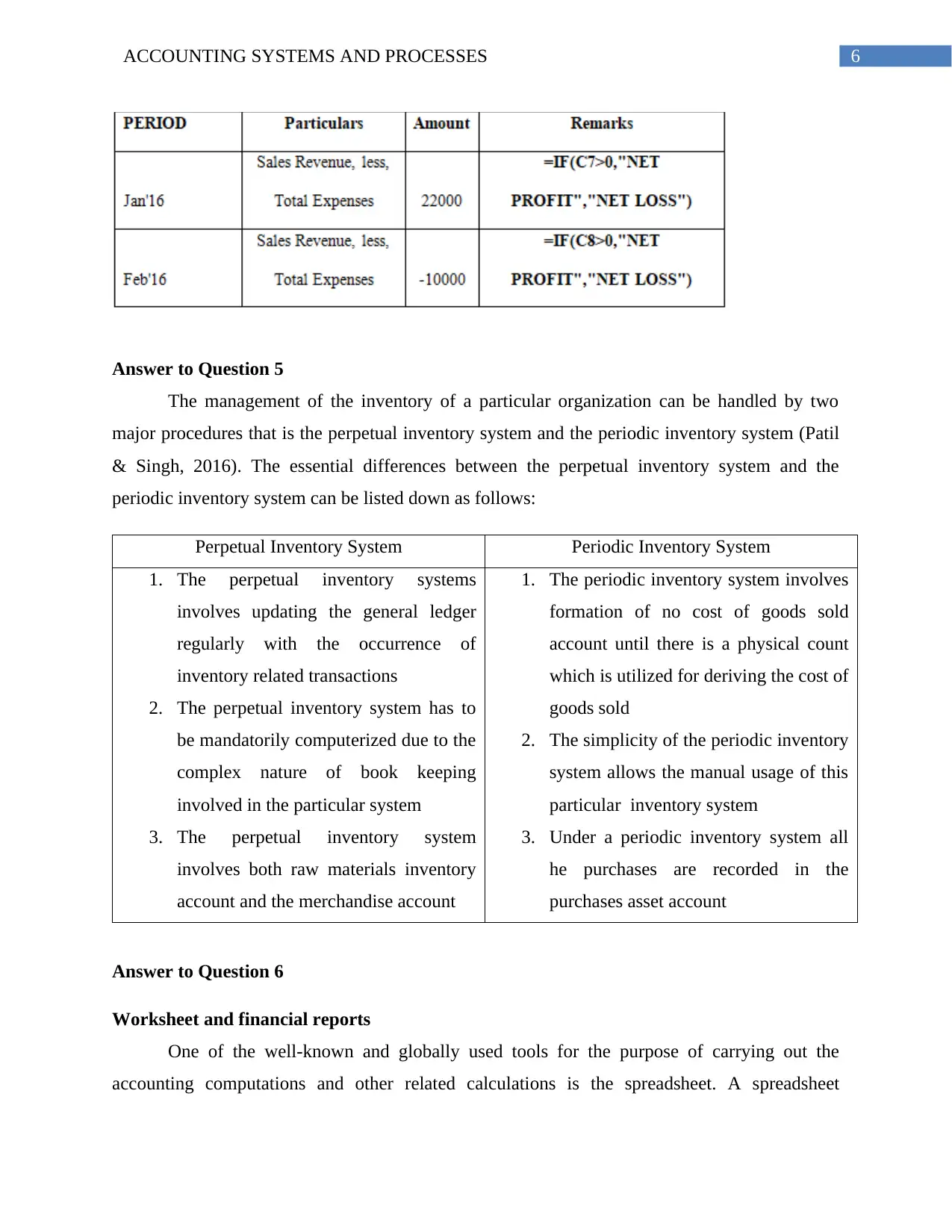
6ACCOUNTING SYSTEMS AND PROCESSES
Answer to Question 5
The management of the inventory of a particular organization can be handled by two
major procedures that is the perpetual inventory system and the periodic inventory system (Patil
& Singh, 2016). The essential differences between the perpetual inventory system and the
periodic inventory system can be listed down as follows:
Perpetual Inventory System Periodic Inventory System
1. The perpetual inventory systems
involves updating the general ledger
regularly with the occurrence of
inventory related transactions
2. The perpetual inventory system has to
be mandatorily computerized due to the
complex nature of book keeping
involved in the particular system
3. The perpetual inventory system
involves both raw materials inventory
account and the merchandise account
1. The periodic inventory system involves
formation of no cost of goods sold
account until there is a physical count
which is utilized for deriving the cost of
goods sold
2. The simplicity of the periodic inventory
system allows the manual usage of this
particular inventory system
3. Under a periodic inventory system all
he purchases are recorded in the
purchases asset account
Answer to Question 6
Worksheet and financial reports
One of the well-known and globally used tools for the purpose of carrying out the
accounting computations and other related calculations is the spreadsheet. A spreadsheet
Answer to Question 5
The management of the inventory of a particular organization can be handled by two
major procedures that is the perpetual inventory system and the periodic inventory system (Patil
& Singh, 2016). The essential differences between the perpetual inventory system and the
periodic inventory system can be listed down as follows:
Perpetual Inventory System Periodic Inventory System
1. The perpetual inventory systems
involves updating the general ledger
regularly with the occurrence of
inventory related transactions
2. The perpetual inventory system has to
be mandatorily computerized due to the
complex nature of book keeping
involved in the particular system
3. The perpetual inventory system
involves both raw materials inventory
account and the merchandise account
1. The periodic inventory system involves
formation of no cost of goods sold
account until there is a physical count
which is utilized for deriving the cost of
goods sold
2. The simplicity of the periodic inventory
system allows the manual usage of this
particular inventory system
3. Under a periodic inventory system all
he purchases are recorded in the
purchases asset account
Answer to Question 6
Worksheet and financial reports
One of the well-known and globally used tools for the purpose of carrying out the
accounting computations and other related calculations is the spreadsheet. A spreadsheet
Paraphrase This Document
Need a fresh take? Get an instant paraphrase of this document with our AI Paraphraser
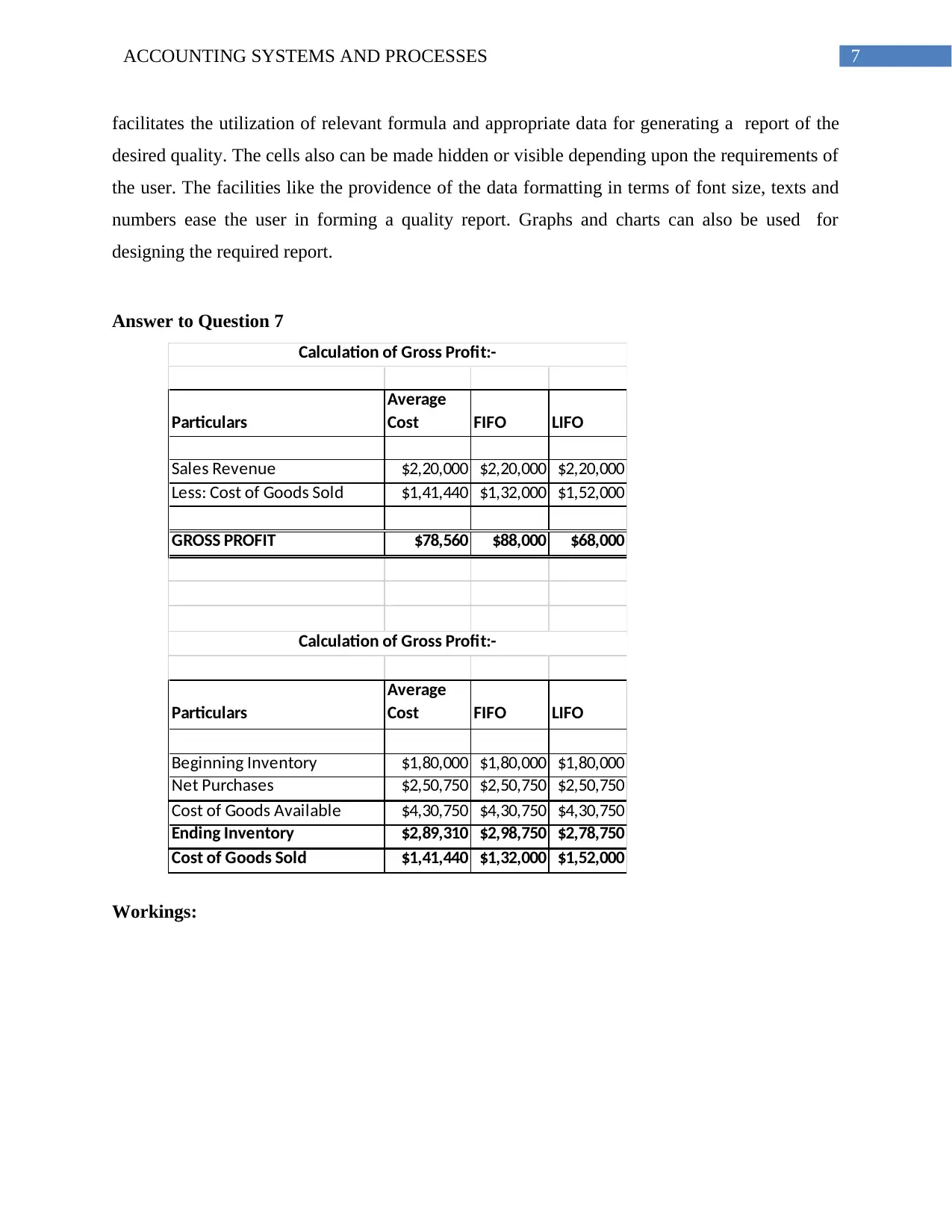
7ACCOUNTING SYSTEMS AND PROCESSES
facilitates the utilization of relevant formula and appropriate data for generating a report of the
desired quality. The cells also can be made hidden or visible depending upon the requirements of
the user. The facilities like the providence of the data formatting in terms of font size, texts and
numbers ease the user in forming a quality report. Graphs and charts can also be used for
designing the required report.
Answer to Question 7
Particulars
Average
Cost FIFO LIFO
Sales Revenue $2,20,000 $2,20,000 $2,20,000
Less: Cost of Goods Sold $1,41,440 $1,32,000 $1,52,000
GROSS PROFIT $78,560 $88,000 $68,000
Particulars
Average
Cost FIFO LIFO
Beginning Inventory $1,80,000 $1,80,000 $1,80,000
Net Purchases $2,50,750 $2,50,750 $2,50,750
Cost of Goods Available $4,30,750 $4,30,750 $4,30,750
Ending Inventory $2,89,310 $2,98,750 $2,78,750
Cost of Goods Sold $1,41,440 $1,32,000 $1,52,000
Calculation of Gross Profit:-
Calculation of Gross Profit:-
Workings:
facilitates the utilization of relevant formula and appropriate data for generating a report of the
desired quality. The cells also can be made hidden or visible depending upon the requirements of
the user. The facilities like the providence of the data formatting in terms of font size, texts and
numbers ease the user in forming a quality report. Graphs and charts can also be used for
designing the required report.
Answer to Question 7
Particulars
Average
Cost FIFO LIFO
Sales Revenue $2,20,000 $2,20,000 $2,20,000
Less: Cost of Goods Sold $1,41,440 $1,32,000 $1,52,000
GROSS PROFIT $78,560 $88,000 $68,000
Particulars
Average
Cost FIFO LIFO
Beginning Inventory $1,80,000 $1,80,000 $1,80,000
Net Purchases $2,50,750 $2,50,750 $2,50,750
Cost of Goods Available $4,30,750 $4,30,750 $4,30,750
Ending Inventory $2,89,310 $2,98,750 $2,78,750
Cost of Goods Sold $1,41,440 $1,32,000 $1,52,000
Calculation of Gross Profit:-
Calculation of Gross Profit:-
Workings:
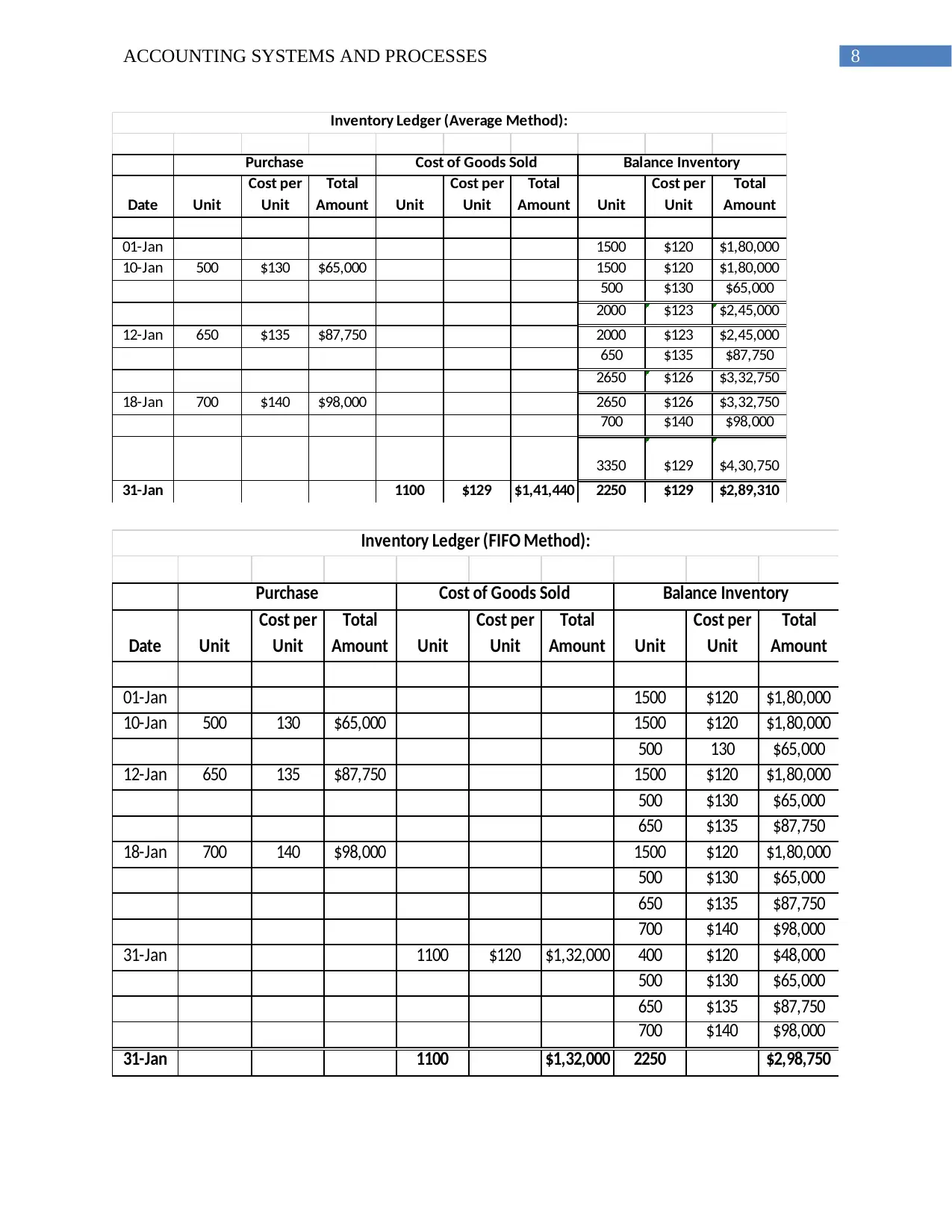
8ACCOUNTING SYSTEMS AND PROCESSES
Date Unit
Cost per
Unit
Total
Amount Unit
Cost per
Unit
Total
Amount Unit
Cost per
Unit
Total
Amount
01-Jan 1500 $120 $1,80,000
10-Jan 500 $130 $65,000 1500 $120 $1,80,000
500 $130 $65,000
2000 $123 $2,45,000
12-Jan 650 $135 $87,750 2000 $123 $2,45,000
650 $135 $87,750
2650 $126 $3,32,750
18-Jan 700 $140 $98,000 2650 $126 $3,32,750
700 $140 $98,000
3350 $129 $4,30,750
31-Jan 1100 $129 $1,41,440 2250 $129 $2,89,310
Purchase Cost of Goods Sold Balance Inventory
Inventory Ledger (Average Method):
Date Unit
Cost per
Unit
Total
Amount Unit
Cost per
Unit
Total
Amount Unit
Cost per
Unit
Total
Amount
01-Jan 1500 $120 $1,80,000
10-Jan 500 130 $65,000 1500 $120 $1,80,000
500 130 $65,000
12-Jan 650 135 $87,750 1500 $120 $1,80,000
500 $130 $65,000
650 $135 $87,750
18-Jan 700 140 $98,000 1500 $120 $1,80,000
500 $130 $65,000
650 $135 $87,750
700 $140 $98,000
31-Jan 1100 $120 $1,32,000 400 $120 $48,000
500 $130 $65,000
650 $135 $87,750
700 $140 $98,000
31-Jan 1100 $1,32,000 2250 $2,98,750
Inventory Ledger (FIFO Method):
Purchase Cost of Goods Sold Balance Inventory
Date Unit
Cost per
Unit
Total
Amount Unit
Cost per
Unit
Total
Amount Unit
Cost per
Unit
Total
Amount
01-Jan 1500 $120 $1,80,000
10-Jan 500 $130 $65,000 1500 $120 $1,80,000
500 $130 $65,000
2000 $123 $2,45,000
12-Jan 650 $135 $87,750 2000 $123 $2,45,000
650 $135 $87,750
2650 $126 $3,32,750
18-Jan 700 $140 $98,000 2650 $126 $3,32,750
700 $140 $98,000
3350 $129 $4,30,750
31-Jan 1100 $129 $1,41,440 2250 $129 $2,89,310
Purchase Cost of Goods Sold Balance Inventory
Inventory Ledger (Average Method):
Date Unit
Cost per
Unit
Total
Amount Unit
Cost per
Unit
Total
Amount Unit
Cost per
Unit
Total
Amount
01-Jan 1500 $120 $1,80,000
10-Jan 500 130 $65,000 1500 $120 $1,80,000
500 130 $65,000
12-Jan 650 135 $87,750 1500 $120 $1,80,000
500 $130 $65,000
650 $135 $87,750
18-Jan 700 140 $98,000 1500 $120 $1,80,000
500 $130 $65,000
650 $135 $87,750
700 $140 $98,000
31-Jan 1100 $120 $1,32,000 400 $120 $48,000
500 $130 $65,000
650 $135 $87,750
700 $140 $98,000
31-Jan 1100 $1,32,000 2250 $2,98,750
Inventory Ledger (FIFO Method):
Purchase Cost of Goods Sold Balance Inventory
⊘ This is a preview!⊘
Do you want full access?
Subscribe today to unlock all pages.

Trusted by 1+ million students worldwide
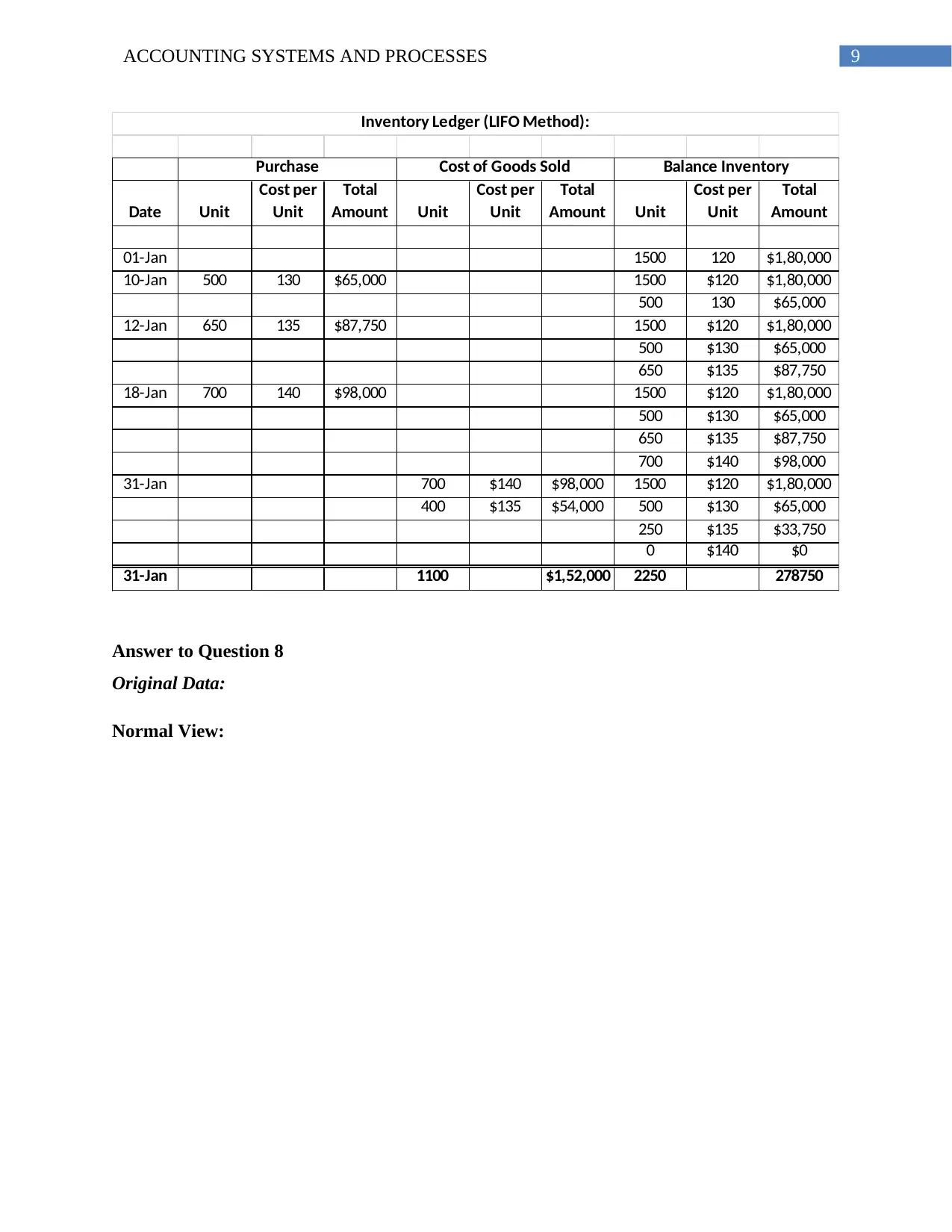
9ACCOUNTING SYSTEMS AND PROCESSES
Date Unit
Cost per
Unit
Total
Amount Unit
Cost per
Unit
Total
Amount Unit
Cost per
Unit
Total
Amount
01-Jan 1500 120 $1,80,000
10-Jan 500 130 $65,000 1500 $120 $1,80,000
500 130 $65,000
12-Jan 650 135 $87,750 1500 $120 $1,80,000
500 $130 $65,000
650 $135 $87,750
18-Jan 700 140 $98,000 1500 $120 $1,80,000
500 $130 $65,000
650 $135 $87,750
700 $140 $98,000
31-Jan 700 $140 $98,000 1500 $120 $1,80,000
400 $135 $54,000 500 $130 $65,000
250 $135 $33,750
0 $140 $0
31-Jan 1100 $1,52,000 2250 278750
Inventory Ledger (LIFO Method):
Purchase Cost of Goods Sold Balance Inventory
Answer to Question 8
Original Data:
Normal View:
Date Unit
Cost per
Unit
Total
Amount Unit
Cost per
Unit
Total
Amount Unit
Cost per
Unit
Total
Amount
01-Jan 1500 120 $1,80,000
10-Jan 500 130 $65,000 1500 $120 $1,80,000
500 130 $65,000
12-Jan 650 135 $87,750 1500 $120 $1,80,000
500 $130 $65,000
650 $135 $87,750
18-Jan 700 140 $98,000 1500 $120 $1,80,000
500 $130 $65,000
650 $135 $87,750
700 $140 $98,000
31-Jan 700 $140 $98,000 1500 $120 $1,80,000
400 $135 $54,000 500 $130 $65,000
250 $135 $33,750
0 $140 $0
31-Jan 1100 $1,52,000 2250 278750
Inventory Ledger (LIFO Method):
Purchase Cost of Goods Sold Balance Inventory
Answer to Question 8
Original Data:
Normal View:
Paraphrase This Document
Need a fresh take? Get an instant paraphrase of this document with our AI Paraphraser
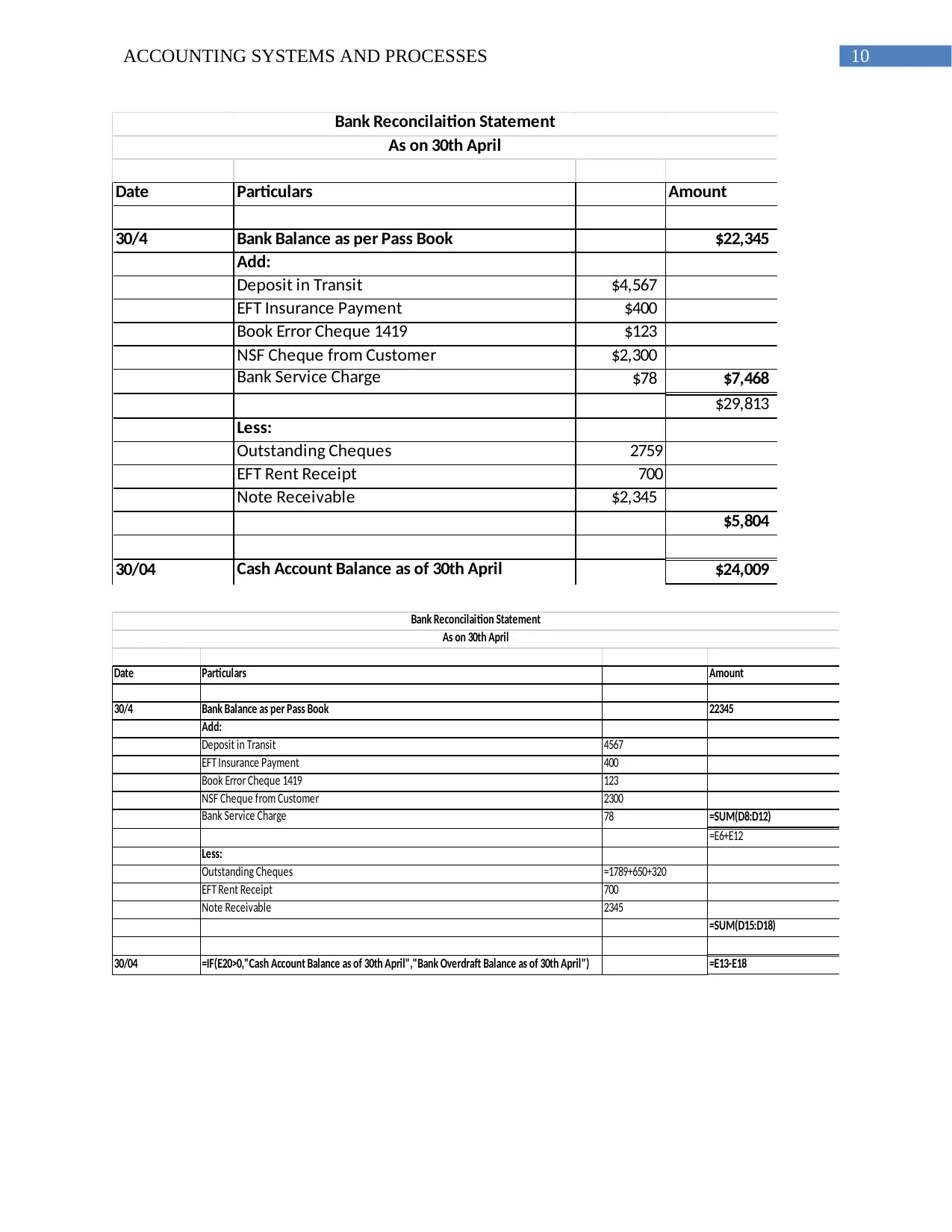
10ACCOUNTING SYSTEMS AND PROCESSES
Date Particulars Amount
30/4 Bank Balance as per Pass Book $22,345
Add:
Deposit in Transit $4,567
EFT Insurance Payment $400
Book Error Cheque 1419 $123
NSF Cheque from Customer $2,300
Bank Service Charge $78 $7,468
$29,813
Less:
Outstanding Cheques 2759
EFT Rent Receipt 700
Note Receivable $2,345
$5,804
30/04 Cash Account Balance as of 30th April $24,009
Bank Reconcilaition Statement
As on 30th April
Date Particulars Amount
30/4 Bank Balance as per Pass Book 22345
Add:
Deposit in Transit 4567
EFT Insurance Payment 400
Book Error Cheque 1419 123
NSF Cheque from Customer 2300
Bank Service Charge 78 =SUM(D8:D12)
=E6+E12
Less:
Outstanding Cheques =1789+650+320
EFT Rent Receipt 700
Note Receivable 2345
=SUM(D15:D18)
30/04 =IF(E20>0,"Cash Account Balance as of 30th April","Bank Overdraft Balance as of 30th April") =E13-E18
Bank Reconcilaition Statement
As on 30th April
Date Particulars Amount
30/4 Bank Balance as per Pass Book $22,345
Add:
Deposit in Transit $4,567
EFT Insurance Payment $400
Book Error Cheque 1419 $123
NSF Cheque from Customer $2,300
Bank Service Charge $78 $7,468
$29,813
Less:
Outstanding Cheques 2759
EFT Rent Receipt 700
Note Receivable $2,345
$5,804
30/04 Cash Account Balance as of 30th April $24,009
Bank Reconcilaition Statement
As on 30th April
Date Particulars Amount
30/4 Bank Balance as per Pass Book 22345
Add:
Deposit in Transit 4567
EFT Insurance Payment 400
Book Error Cheque 1419 123
NSF Cheque from Customer 2300
Bank Service Charge 78 =SUM(D8:D12)
=E6+E12
Less:
Outstanding Cheques =1789+650+320
EFT Rent Receipt 700
Note Receivable 2345
=SUM(D15:D18)
30/04 =IF(E20>0,"Cash Account Balance as of 30th April","Bank Overdraft Balance as of 30th April") =E13-E18
Bank Reconcilaition Statement
As on 30th April
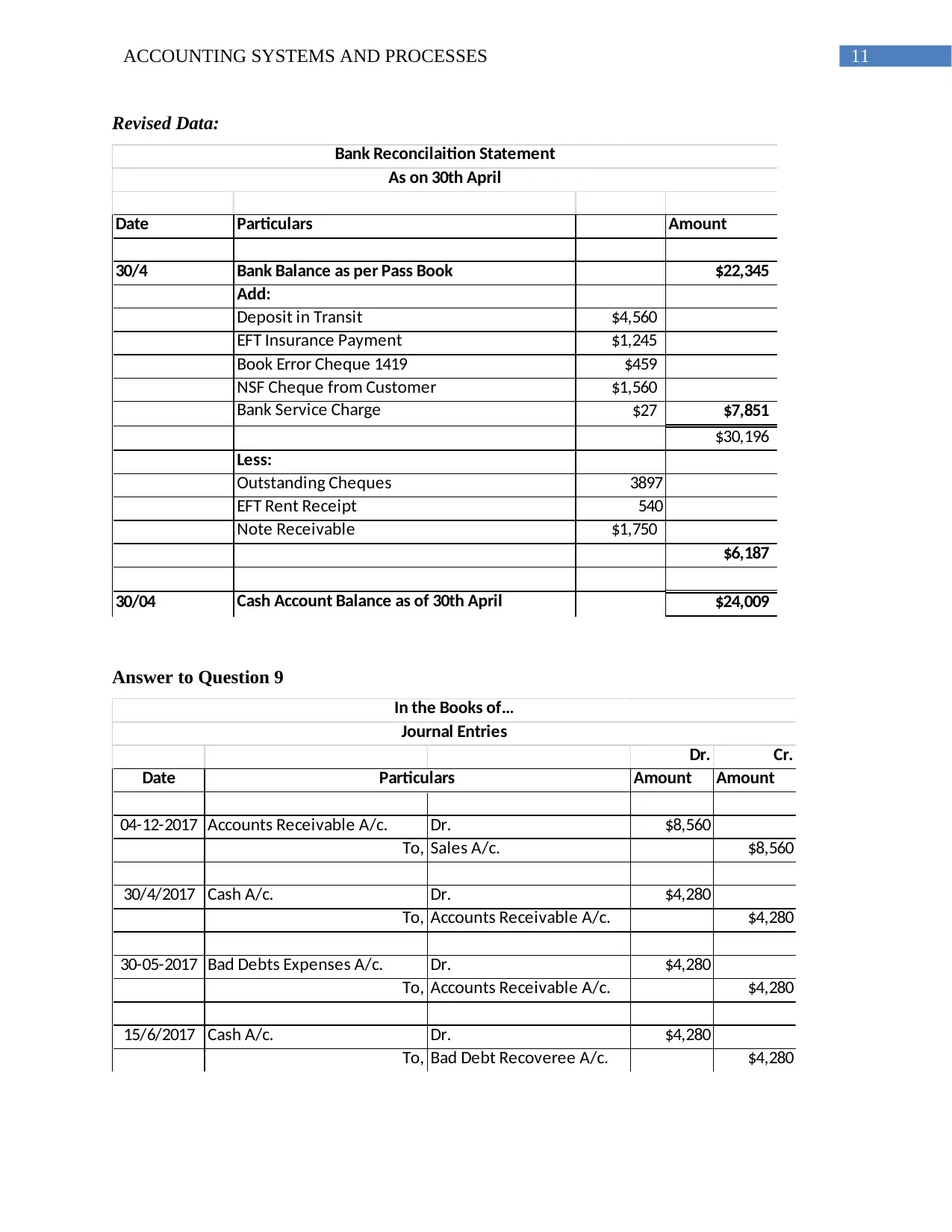
11ACCOUNTING SYSTEMS AND PROCESSES
Revised Data:
Date Particulars Amount
30/4 Bank Balance as per Pass Book $22,345
Add:
Deposit in Transit $4,560
EFT Insurance Payment $1,245
Book Error Cheque 1419 $459
NSF Cheque from Customer $1,560
Bank Service Charge $27 $7,851
$30,196
Less:
Outstanding Cheques 3897
EFT Rent Receipt 540
Note Receivable $1,750
$6,187
30/04 Cash Account Balance as of 30th April $24,009
Bank Reconcilaition Statement
As on 30th April
Answer to Question 9
Dr. Cr.
Date Amount Amount
04-12-2017 Accounts Receivable A/c. Dr. $8,560
To, Sales A/c. $8,560
30/4/2017 Cash A/c. Dr. $4,280
To, Accounts Receivable A/c. $4,280
30-05-2017 Bad Debts Expenses A/c. Dr. $4,280
To, Accounts Receivable A/c. $4,280
15/6/2017 Cash A/c. Dr. $4,280
To, Bad Debt Recoveree A/c. $4,280
Particulars
In the Books of…
Journal Entries
Revised Data:
Date Particulars Amount
30/4 Bank Balance as per Pass Book $22,345
Add:
Deposit in Transit $4,560
EFT Insurance Payment $1,245
Book Error Cheque 1419 $459
NSF Cheque from Customer $1,560
Bank Service Charge $27 $7,851
$30,196
Less:
Outstanding Cheques 3897
EFT Rent Receipt 540
Note Receivable $1,750
$6,187
30/04 Cash Account Balance as of 30th April $24,009
Bank Reconcilaition Statement
As on 30th April
Answer to Question 9
Dr. Cr.
Date Amount Amount
04-12-2017 Accounts Receivable A/c. Dr. $8,560
To, Sales A/c. $8,560
30/4/2017 Cash A/c. Dr. $4,280
To, Accounts Receivable A/c. $4,280
30-05-2017 Bad Debts Expenses A/c. Dr. $4,280
To, Accounts Receivable A/c. $4,280
15/6/2017 Cash A/c. Dr. $4,280
To, Bad Debt Recoveree A/c. $4,280
Particulars
In the Books of…
Journal Entries
⊘ This is a preview!⊘
Do you want full access?
Subscribe today to unlock all pages.

Trusted by 1+ million students worldwide
1 out of 19
Related Documents
Your All-in-One AI-Powered Toolkit for Academic Success.
+13062052269
info@desklib.com
Available 24*7 on WhatsApp / Email
![[object Object]](/_next/static/media/star-bottom.7253800d.svg)
Unlock your academic potential
Copyright © 2020–2025 A2Z Services. All Rights Reserved. Developed and managed by ZUCOL.





